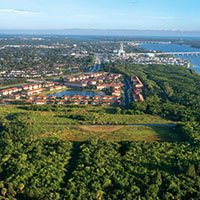 Residents fume over muck storage plan near lagoon
Residents fume over muck storage plan near lagoon
STORY BY STEVEN M. THOMAS (Week of November 6, 2025)
Residents of Provence Bay, a mainland community of Spanish revival townhomes and villas a mile south of the 17th Street Bridge, are up in arms over the Florida Inland Navigation District’s plan to store 163,000 cubic yards of dredged muck in a huge earthen structure next door to their homes.
Less than a month ago, the residents were notified that FIND intends to dig a canal and construct a dredge material basin just south of their community to hold muck that will be removed from a stretch of the Intercoastal Waterway running from Grand Harbor down to the St. Lucie County line.
Homeowners say they fear construction noise and dust, foul smells from the muck that FIND plans to remove from the Intracoastal Waterway, toxic material, flooding, swarms of mosquitoes due to standing water, and reduced property values.
“My level of concern is 10 out of 10,” says Jeff Clay, a dentist who lives in Sandpointe on the island and owns a home on Monaco Place in Provence Bay that backs up to FIND’s 54-acre parcel. His wife’s parents, both in their 80s, reside in the home.
“My concerns start with the adverse effect this project will have on our property values,” says Lisa Scardino, who owns a 1,900-square-foot townhome at the southern end of Chevel Drive, right next to FIND’s acreage, according to property records.
Drawings included in a public notice published by the U.S. Army Corps of Engineers on Sept. 30 show a new canal running within 50 feet of Scardino’s and Clay’s property, and Scardino also fears flooding.
“In the eight years we’ve lived here, we have been hit by three hurricanes – Irma, Nicole and Milton – and every one of them changed that field into a lake that came dangerously close to flooding our home,” says Scardino. “That was without a dike, canal and reservoir in the middle of it!”
FIND drawings show the dike around the muck basin rising 14 feet above sea level, which is 7 feet above the existing grade in Provence Bay.
A Sept. 30 public notice was posted by the U.S. Army Corps of Engineers to let people know that FIND had applied for a Clean Water Act environmental permit needed prior to construction.
It states that “the 53.38-acre dredge material management area (DMMA) site is located just south of Vero Beach, Florida, extending from Indian River Boulevard to the Indian River Lagoon, a designated Aquatic Preserve . . . The site is bounded to the north by residential housing and to the south by the Lagoon Greenway, which includes a portion of the Lagoon Greenway Loop Trail.”
A designated aquatic preserve might seem like a strange place to build a hulking muck storage basin – which will occupy about a third of FIND’s parcel – but inland storage of dredged material actually began due to environmental concerns.
During and before the 1960s, when FIND dredged the Indian River navigation channel, it piled the muck up outside the channel to create the many “spoil islands” that dot the lagoon, and to fill wetlands that were wanted for development. Riverside Park was created out of swampland by this means, according to Indian River County Historian Ruth Stanbridge.
In the 1960s and 1970s, scientists determined that creating spoil islands and filling wetlands damaged the aquatic environment and laws were passed that required dredge material to be stored inland to sequester any toxins or materials that would cloud the lagoon’s then Key West-clear water.
Then and thereafter, FIND began to plan for inland storage and acquire DMMAs, or dredge material management areas, up and down the length of the lagoon.
“FIND has purchased properties at various intervals along the lagoon to make dredging more efficient,” FIND executive director Janet Zimmerman told Vero Beach 32963. “You can only pump the material so far before you have to add booster pumps and it becomes more difficult and expensive to get the dredging done.”
As part of that process, FIND selected three sites in Indian River County, including the site by Provence Bay, which is designated DMMA IR-14 in official documents.
In the mid-1990s, FIND conducted an extensive evaluation of the Vero Beach site that included soil and water testing, examination of plant and animal life on the parcel, and input from state agencies and a local citizens advisory committee to determine if DMMA IR-14 was a suitable location for muck storage.
The answer was yes, and the agency purchased five parcels of land totaling about 54 acres from the state and several private owners, paying between $11,000 and $84,000 per acre.
But all of that was years before Provence Bay existed. The community’s earliest phases were built in 2007, so the neighborhood was not considered in FIND’s initial examination of the property.
FIND’s land lay fallow for more than two decades and most people moving into the community were blissfully unaware that a major construction project was planned for some point in the future next door to their subdivision.
Both Clay and Scardino say they were assured by their real estate agents when they purchased their homes that the property to the south was preserve land that would never be developed.
And part of it is. The property that adjoins the south side of FIND’s land belongs to Indian River County and St. Johns River Water Management District, and Indian River Land Trust owns property to the south and north of Provence Bay.
The Lagoon Greenway Trail runs through connected parcels, passing just east of Provence Bay, and Land Trust executive director Ken Grudens says he expects the trail to remain intact where it crosses FIND’s land even if the muck storage pit is built – though it might be closed temporarily due to pipes crossing the trail.
Scardino, Clay and other residents along the southern edge of Provence Bay were informed of U.S. Army Corps of Engineer’s public notice via certified mail in the first and second weeks of October.
The notice solicited comments from community residents and other interested parties but gave them only until Oct. 21 to respond. After complaints about the tight timeframe, the Corps extended the comment period to Oct. 30.
The notice states that the Corps will hold a public meeting to provide information and hear citizen feedback if one is requested and multiple Provence Bay residents have asked for an in-person meeting.
A time for the presentation/meeting has not been announced, but the approval process is ongoing.
The last time FIND built a dredge material basin in the county in 2011-2012 two miles south of Sebastian, there was a fair amount of controversy.
Hundreds of citizens, members of the county commission and state lawmakers pressed FIND to test the muck it planned to store at the site and otherwise ensure the safety of surrounding residents. FIND complied and eventually completed the storage facility. It has since been used in several dredging operations but is not full, according to Zimmerman.
If FIND secures its Clean Water Act permit from the Corps, along with all other needed approvals, the Corps will build the impoundment.
According to the Corps, FIND is committed to balancing environmental and community concerns with the practical necessities of its mandate to maintain a 12-foot depth along the length of the Intracoastal Waterway for recreational boating, commerce and national security purposes.
Seeking that balance, FIND revised its original plan, reducing the size of basin and moving it westward to avoid harming 19 acres of mangrove wetlands on the shore of the lagoon. Revision also brought the project closer to Provence Bay.
FIND is a special taxing district created by the Florida Legislature in 1927 to create and keep open an inland waterway along Florida’s Atlantic Coast. Maps on the district’s website show shoaling – an accumulation of muck that reduces the navigation channel’s depth – along the Indian River County stretch of the waterway that necessitates dredging.
Zimmerman expects construction to be complete by the end of 2026, with dredging to follow several years later.
“The dikes have to settle for a year or two before material can be placed in the basin,” Zimmerman says.



